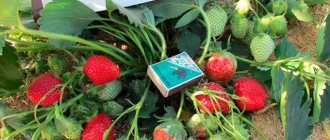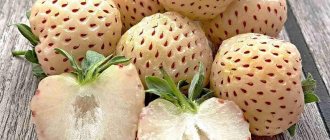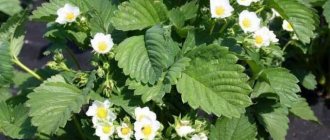Frigo strawberry is not a variety of large-fruited garden strawberry, as many people think, but a method of cultivation. This is a special technology for storing and selling seedlings - from the moment of purchase to planting in the ground. Frigo seedlings are large-fruited, almost disease-free, do not attract pests, and begin to produce crops in 1.5-2 months. The fruits are tasty, sweet, juicy, beautiful, just like a berry after another. In general, there are many advantages.
What are frigo strawberries - variety or technology
Translated from Italian, “frigo” means “cold”, which means that the method of growing garden crops occurs through exposure to cold, that is, freezing.
What are strawberries frigo? Many people think that frigo strawberry is some kind of new variety of large garden strawberry. This is not a variety, but a special technology for cold storage with further planting in the ground.
Brief description of frigo technology:
- First, young seedlings are obtained from the mother plant, and in late autumn, when the plants enter the dormant phase, they are dug up. At this time, the plantings already have a strong rhizome and a healthy above-ground part.
- Then they are laid out in special containers and stored in refrigerators at a temperature of -2 degrees.
- Frigos go on sale at the end of winter. The planting time for this crop is from March to June. They are defrosted and then planted in the garden beds.
The survival rate of frozen seedlings is almost 100%. They do not need particularly careful care like regular strawberries. But in order for strawberry seedlings to begin producing berries after a long period of dormancy, they need to create special conditions.
Reviews from gardeners
Gardeners and farm owners who plant frigo strawberries note its pros and cons.
The advantages of the technology include:
- the ability to harvest crops all year round, even out of season;
- rapid ripening of fruits after planting;
- ability to resist diseases;
- high yields of high-class seedlings;
- young plants take root well and quickly.
Among the disadvantages are noted:
- high price of seedlings;
- difficulty in creating conditions for storing seedlings, the need for a certain regime, the use of expensive equipment;
- Early fruiting of strawberries grown using this method is possible only in the first year after planting, after which the strawberries become ordinary.
Frigo is a unique technology, which is currently mostly mastered by large farms for growing strawberry crops for sale. But the positive aspects of using technology are gradually introducing it into small gardening for personal use.
Classification into groups of frigo strawberries
Garden strawberry varieties are divided into 4 classes based on neck diameter.
The neck is the part of the bush from the leaf rosette to the rhizome.
Taking into account the diameter of the root collar, the seedlings are divided into classes. The resulting groups are: “B” class, “A” – class, “A” + class and the champion in yield - WB class.
In the middle zone, frigo seedlings can be planted at intervals of 14 days (planting time is early May - mid-July). Then enjoy delicious strawberries for a long time, from June to early September. In the southern regions, growing times are much longer.
Even the high price of planting material will cover all costs already in the first year of cultivation. Next year you can also expect a bountiful harvest of frigo strawberries.
Strawberry frigo a extra
Strawberry frigo “A” extra is a group that includes very expensive varieties, but the abundance of the harvest (20 tons per 1 hectare) will quickly cover all expenses.
The diameter of the neck can reach 2.5 cm in diameter. Each bush grows 5 flower stalks. The berries turn red already in the first year, not only on the main peduncles, but also on the side shoots. In a greenhouse, the berry harvest can be obtained within 1.5 months after planting the bushes.
Strawberry frigo a-
“A” class strawberries have a neck diameter of 8-12 mm. The fruits begin to appear in the year of planting. The seedlings produce 2 flower stalks and produce 200 g of berries per bush.
Owners of summer cottages often buy this particular group. The first berries delight the owners already in the first year after planting the planting material.
Strawberry frigo a+
Frigo “A”+ strawberries are the most popular group. Seedlings of this class have a more powerful horn. Its diameter is 12-15 mm. They begin to bear fruit already in the first year after planting, which is why they are so valued by owners of large acreage.
Another valuable property is that berries can remain healthy for a long time, much longer than other classes. The price of planting material is quite high, but it pays off already in the first planting season. Each bush produces 150-250 g of berries.
Frigo's strawberry
Gardeners are not too fond of the frigo “B” strawberry. Frigo seedlings of this class do not have a very strong root, the diameter of the neck is 6-8 mm. The seedlings form a single peduncle. In order to get a good harvest in the future, the peduncle is regularly cut or plucked.
From the seedlings of this group, the harvest is obtained in subsequent years from the date of planting.
Preparation
The process of preparing for landing is a little unusual. The plant undergoes certain operations and requires a careful approach.
Soils
- Areas in the shade, lowlands with high humidity and slopes with low humidity are not suitable for planting strawberries. Choose sunny flat areas.
- The soil of the seedlings must be nutritious. The site is fertilized with a mixture of 10 kg of manure, 30 g of potassium salt, 60 g of superphosphate per square meter of soil.
- Weed, completely destroying weeds.
- The soil is well moistened.
Seedlings and photos
- Before planting, seedlings must be awakened. To do this, keep it in a closed package at room temperature for 24 hours. A sudden change in temperature will cause heatstroke.
- After defrosting, the rhizomes are trimmed, leaving a length of 10-12 cm, and placed in water to absorb moisture lost during storage.
- After soaking properly, the seedlings are immediately planted in the prepared area.
Planting process
The seedlings are bunches of brown roots and a rosette with leaf buds. The roots are properly straightened and lowered into holes prepared in advance. They should be distributed freely in the soil, not in a bunch, without creases. The distance between seedlings is 30 cm. After planting, the soil around the bush should be compacted so that there are no voids left at the roots. Seedlings need to be watered abundantly.
Attention! When planting, monitor the level of the root rosette: if you cover it with soil, the roots will get wet when watering; If you leave it in the air, the roots will dry out!
Strawberries can be planted on high ridges; this is especially important if the site is in a lowland or close to the groundwater surface. You can form strip or double-sided beds.
Harvesting seedlings
What are frigo seedlings? In appearance, frigo seedlings are a rhizome without leaves. They are removed before being sent for storage. Frigo seedlings are harvested late in the fall, when it is already cold outside.
Stages of obtaining seedlings:
- Mother bushes are planted in loose soil. Peduncles must be trimmed first. Pruning flower stalks in the first year helps the plant devote all its energy to producing new seedlings.
- During the season, one-year-old seedlings grow. In late autumn, the bushes stop growing, but begin to lay buds. This stage is called the "resting phase". The appearance of the bush will make it clear that it has entered this stage. The root turns brown, but the tips remain light; the leaves become dark brown. Most often this happens in early November. If you dig up earlier, the planting material will not withstand freezing.
- The seedlings are dug up, all the leaves are torn off, the rhizome is washed, treated against pests, sorted into categories, then sent for storage in special cold chambers for freezing.
After planting in the beds, the plants quickly begin to produce crops because they have not spent nutrients fighting for survival.
The berries begin to ripen 1.5 months after planting.
What is the effectiveness of the Frigo method?
In late autumn, Frigo strawberry seedlings are dug up using special equipment. After this, it is cleaned, excess vegetation is removed, sorted into classes and packaged for storage. Processing of seedlings is carried out in an equipped room with a constant air temperature of 12-14C for 48 hours. Then the processed bundles are placed in a storage chamber, where high humidity of 85-90% and low temperature of 0-1C are maintained. In this frozen form, strawberries can be stored from several weeks to 9-10 months. Plants begin to bear fruit 7-9 weeks after planting.
The peculiarity of this method is that the bushes do not overwinter on ridges, where they may be exposed to various unfavorable factors. Thus, you can get a high yield of quality berries at any time.
If you organize the planting of seedlings correctly at different times, you can get a continuous fruiting cycle, which is very important for large farms and entrepreneurs
In addition, this technology allows you to conveniently transport planting material to any distance without damage to plants. A well-developed root system at the planting site ensures rapid adaptation and survival. In this case, all the nutrients accumulated by the plant are used for the harvest, and not for the development of the bush itself.
Seedling storage
Frigo strawberry seedlings are stored in chambers at temperature (0 to –2°C) and humidity (90%). These winter storage conditions must be observed with particular care. Any deviations from the desired temperature in the chambers can destroy all the workpieces.
If the temperature drops 1 degree lower, the seedlings will freeze and become unsuitable for growing. An increase in temperature of even half a degree is also undesirable. Frigo strawberry seedlings will break dormancy and begin to grow. Early growing season will lead to weakening of the bushes.
If the temperature rises by 1 degree, the seedlings will begin to dehydrate. Dehydrated bushes will quickly die.
Features of planting frigo strawberries
The technology provides for the use of high-yielding crop varieties for planting. Among them:
- Honey;
- Alba;
- Clery;
- Sonata;
- Elsanta;
- Asia;
- Roxana;
- Ducat;
- Shelf;
- CHamora turusi.
Seedlings are sold frozen, packed in sphagnum (moss). When transporting or sending, plants are preserved for up to 21 days.
Frozen frigo strawberry seedlings, after being removed from the refrigerator, should remain in the package for 20-24 hours. Having unpacked the seedlings, they inspect the planting material, making sure that there is no mold or traces of rot on the bushes. After thawing, the roots of the seedlings are soaked in water and only then planted.
For planting use:
- open ground ridges;
- tunnels;
- greenhouses;
- containers, flower pots.
Pots are suitable for temporary planting at home (for example, until the onset of stable heat), after which the bushes are placed in a permanent place.
How to check the quality of frigo seedlings
High-quality planting material is a guarantee of a generous harvest, so when purchasing, pay attention to the appearance of the rhizomes. They should not be too dry.
Conscientious producers of planting material keep them in a moisture-intensive substrate with agroperlite.
There should be no mold on the roots. Mold appears when storage conditions have not been met.
Pay attention to the length of the roots. They must be 20 centimeters or more. The diameter of the root collar is at least 8 mm. The best specimens have a neck with a diameter of 12-18 mm. The photo shows which roots are the most developed.
Plants that emerge from dormancy may have a couple of leaves in full bloom. This is normal. Then the leaves must be removed so that the seedlings do not waste their reserves in advance on growing greenery.
Growing frigo strawberries in open ground
On the site, you can simply plant frigo strawberries in beds according to certain planting patterns, depending on its variety and intensity of cultivation. But a better method is to plant frigo seedlings in fairly high ridges in one or two rows, mulched with straw, agrotextiles or polyethylene.
In the first case, it is preferable to water by sprinkling (a watering can or a hose with a fine spray at the end, a sprinkler, a sprinkler). In the second case, drip irrigation is used (when mulching the bed with plastic film, the watering tape is hidden under it). When watering, the soil should be wet to a depth of at least 30-40 cm.
Soil moisture should always remain consistently high - this is especially important during the rooting period of plants, although it remains relevant throughout the entire growing period until harvest. Otherwise, caring for frigo seedlings does not differ from that with the usual seedling method of propagating strawberries
Otherwise, caring for frigo seedlings does not differ from that with the usual seedling method of propagating strawberries.
High-quality frigo strawberry seedlings usually take root and take root much better than usual, and also develop faster and more evenly. This occurs both due to the initial absence of leaves, and due to the presence of increased reserves of nutrients in the rhizome due to the conditions for collecting and storing planting material (cooling seedlings protects them from wasting effort and energy on pre-germination).
Frigo strawberries, like strawberries grown using conventional technology, also have many varieties suitable for certain regions (Sonata, Alba, Elsanta, Clery, etc.). Choose the one that is suitable for your area and climate zone.
On average, after 2-2.5 months after planting, frigo has time to form sufficient vegetative mass and begins to bear fruit.
So, frigo strawberries have a good survival rate, resistance to diseases and low temperatures, and high yield. “Frozen” seedlings do not need to be thoroughly prepared beforehand and can be stored for a long time. The only disadvantages are the high price of frigo seedlings and the fact that next season your strawberries will no longer be any different from ordinary ones. But why not try growing it on your own plot?
Planting seedlings
The time of purchasing planting material is not so important, be it early spring or late summer; it is more important to plant it in the ground without delay.
A plant removed from a moisture-intensive substrate immediately begins to grow, so you need to prepare the bed in advance. If you plan to plant in the spring, then the bed must be prepared in the fall, and for autumn planting - 2 or 3 weeks in advance.
- Once you have purchased the seedlings, do not let them remain outdoors for long. If you can’t start planting right away, place them in a container of water or sprinkle with damp soil.
- Dig holes slightly larger than the rhizome. Before planting, straighten the roots, then carefully distribute them in the planting hole, making sure that no creases form.
- Then cover the seedlings with soil, lightly compact them and water. The soil needs to be well moistened, so watering should be plentiful.
- The heart or uppermost bud is located at ground level. In this case, the root collar should be covered with earth.
The soil
The soil must be made nutritious, loose, fertilized, and moist. For every kV. per meter of bed, add 10-15 kg of rotted manure, 30-40 g of potassium salt and 50 g of superphosphate. Before planting seedlings, dig up the bed.
It is best to plant young seedlings on high ridges under agrotextiles or mulch. The distance between the bushes is 25-30 cm.
Deadlines
Dates for planting in open ground: from April to August, depending on the weather and region. If frigo seedlings were purchased in February or March, then first plant them in 500 ml pots with nutritious soil. Make sure that the roots do not break. Trim them to the height of the pot and straighten them well. When it gets warm, transplant the strawberries into the garden bed.
Often the timing of planting depends on the variety. You cannot delay planting class A+ “extra” strawberries. The sooner it is in the garden, the better it will begin to grow.
If you ordered frigo seedlings of class “A”, then they will be stored the longest without compromising quality. Frigo class “A”+ seedlings must be planted before mid-June.
If you plant the crop in mid-May, flowers will appear on it in 25-30 days. In about a month you can harvest the first harvest.
Planting later than mid-June is undesirable: firstly, the yield will be much lower than desired, and secondly, abundant fruiting will begin in late August or early September, when it becomes cool at night. Night cooling will negatively affect the quality of the berries: they become small, soft and tasteless.
Stages of work when planting frigo seedlings
The berry bushes are sold frozen. Before landing in a permanent place, they should be “awakened”.
Stages of work:
- Leave the seedlings in a closed package for a day.
- Then remove the film from the seedlings and pour water at room temperature - no warmer!
- Then dissolve a growth stimulator, for example Zircon, Cytovit, in a container of water.
- Place the seed for 2 hours in a container with water at a temperature of 15-18 °C. The solution should not get on the core of the bush, otherwise growth will slow down for a long time.
- You can leave the roots open only for 10-15 minutes. After soaking, trim them by 10 cm and immediately plant them in a permanent place.
After planting, water the bushes and mulch them. Black film with separate slits is suitable as mulch.
Passion for frigo seedlings
If you bought frigo seedlings too early (in February-March), you need to keep them in a dormant state, not allowing the leaves to open (for example, place the phyto bags in the refrigerator). But plants, even in the dark coolness, feel the beginning of spring and begin to grow - they have to be planted in pots. And that's a whole story! Stressful temperature changes and drying out of the root ball should not be allowed. For the first day, the seedlings are kept directly in the package on a cool balcony in a shaded place - for adaptation. On the second day, the seedlings are unpacked, the roots are immersed in water at a strictly defined temperature - street temperature (after all, they were on an open balcony). Then the roots are cut to 5-7 cm and immediately planted in pots or a greenhouse (after all, it’s too early to go into unprotected soil).
It is best to use peat pots - they can be transferred to open ground by transshipment. Plastic cups can be cut to keep the root ball intact. The planting substrate must be loose, moisture-absorbing, nutritious - this is extremely important for frigo. Under no circumstances should the root rosette be buried - if it rots during watering, the plant will die. For the first week, the seedlings are kept in shade at T 10°. Next - like any other seedlings - in a bright place, protected from direct sunlight. You can plant it in open ground in May, after the soil has warmed up.
This is the story with the early purchase of frigo seedlings. You don’t know when they will begin to grow and you will have to work on their adaptation to the open air before planting them on the site. We have deliberately exaggerated the difficulties so that you act carefully and do not lose a single seedling. The effort will pay off - frigo strawberries will produce a tasty, generous harvest for many, many seasons. In addition, now you know that frigo seedlings can withstand a long shelf life - more than six months.
There are no difficulties at all with seedlings purchased in April. Just plant it in the ground.
Care
Caring for frigo strawberries includes watering, fertilizing, controlling diseases and pests, and preparing for winter after harvesting.
Watering frequency
Within 10 days after planting, the berry crop must be irrigated every day. Then, the berries are watered once every 5 days. If it is not possible to water every 5 days, then water as needed. The berries easily tolerate temporary drought.
Fertilizer application
To increase the yield, the berry crop is fed with organic matter or mineral fertilizers. In spring, the bushes are fertilized with organic matter containing nitrogen.
Before flowering, and then at the time of ovary formation, the crop is fed with phosphorus and potassium. In autumn, the soil is enriched with both organic fertilizers and mineral complex preparations.
Pest and disease control
It is better to treat strawberry seedlings with fungicides before planting in a permanent place. In early spring, spray the bushes with insecticides and infusions that are used to treat ordinary strawberries. Infusions are prepared according to folk recipes.
Preparing for winter
The harvest of the next season depends on the proper preparation of strawberries for winter. Immediately after the end of fruiting, it is recommended to carry out the following work: pruning foliage, mulching, treatment against diseases and pests, shelter from frost.
Pros and cons of frigo technology
Of course, modern technology has many advantages. Let's just mention the main ones:
- high productivity;
- ripening of ripe berries 8-9 weeks after planting in the ground;
- guaranteed healthy planting material;
- high level of seedling survival rate;
- the presence of many varieties suitable for different regions and climatic zones;
- the opportunity to get a harvest in the “off season”.
However, the overseas miracle also has disadvantages:
- seedlings are more expensive than usual;
- Strawberries are early-fruiting only in the first year, and then they are no different from ordinary berries.
According to professional gardeners, growing frigo strawberries is a real breakthrough. So maybe you should try an unusual and very promising seedling in the coming season?
Advantages of frigo seedlings
Even with all the complexity of growing this berry crop, the method is endowed with many advantages:
- Frigo strawberries do not freeze even in very harsh winters, unlike ordinary garden strawberries;
- Powerful rhizomes do not rot or get wet, since digging occurs before the onset of prolonged cold rains;
- During storage, fungal infections do not develop on the seedlings, because all leaves are torn off before being placed in the chambers;
- The plants are covered with fruits a month after planting.
Care and feeding
Strawberries quickly take root, growth begins, and after a few days leaves appear.
- It is necessary to regularly loosen the soil and remove emerging weeds.
- Mulching with straw, hay, sawdust is possible.
- It should be fed with complex fertilizers. The first time this is done a month after planting during or immediately after rain. Feeding is possible throughout the entire flowering period.
- It is necessary to monitor the level of nitrogen in the soil to prevent plant diseases. If there is an oversaturation of nitrogen, strawberries may die.
Peculiarity! If you grow strawberries for seedlings, remove all emerging flower stalks; if your goal is to quickly harvest a mature harvest, you need to remove all the whiskers. One bush cannot produce both high-quality seedlings and a tasty harvest!
Choosing a landing site
Frigo strawberries are planted on a flat, weed-free, well-fertilized area. The ridges are created about twenty centimeters high. Experts believe that the best predecessors are green manure: for example, autumn sowing of mustard, legumes, rapeseed, followed by plowing of green mass in the spring. It will be an excellent soil fertilizer.
You can add manure in the fall. This measure is especially effective on light, depleted soils. Before planting, mineral fertilizer should be applied. Gardeners believe that Azofoska is the most convenient to use. The granules do not need to be embedded deeply into the soil: the fertilizer dissolves well and easily penetrates into the soil with rain (or watering). It can be applied both when cutting furrows and superficially - from 800 g to 1.5 kg. The dosage depends on the soil and whether green fertilizer or organic matter was previously applied.
Classification of seedlings
Many people are interested in what kind of seedlings are frigo, how to plant and care for plants. In Europe, a table of distribution by groups has been adopted. The criterion is the size of the diameter of the root collar (see photo). Frigo seedlings are annual garden strawberry seedlings with an open root system. They are grown by sowing seeds of elite mother plants.
Seedlings of group WB are considered productive themselves, so their cost is higher than that of seedlings of group B.
| Group | Root neck thickness (cm) | Peculiarities |
| B | 0,8-1,2 | Forms 1 peduncle. In the first year there is no fruiting. |
| A | 1,2-1,5 | Two peduncles, in the first year it produces up to 15-20 berries per plant. |
| A+ | 1,5-1,8 | Three peduncles, fruiting in the first year, up to 30-35 berries per plant. |
| W.B. | from 2.0 | Elite seedlings, 4-5 flower stalks. Harvesting in the first year, the number of berries is 40-50 pieces. |











